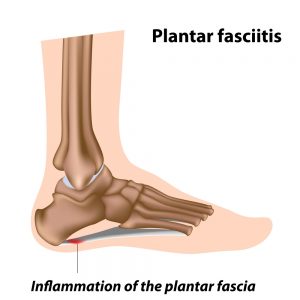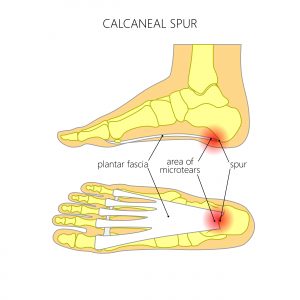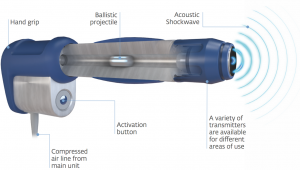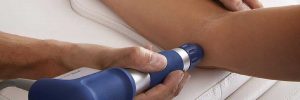Plantar Fasciitis and Heels spurs; Shockwave Therapy could provide a solution!!
Posted by Phil Heler, MD on June 23, 2018Plantar Fasciitis and Calcaneal Heel Spurs can be treated effectively using Shockwave Therpay
What is Plantar Fasciitis?
Plantar fasciitis is one of the most common causes of foot pain that we see. The plantar fascia is a thick band of strong connective tissue that connects and stretches the heel to the toes in your foot. The plantar fascia serves as both a means of protection and support to the arch of your foot. A simple metaphor would be a structure organised like a bowstring that is designed to both attenuate and absorb shock.
The basic underlying principal would be that if the tension in the bowstring becomes too extensive and repetitive (e.g. long-distance running), small tears develop that lead to inflammation and irritation where the fascia inserts on the heel bone. Causes are multifarious and often there can be no apparent reason.
Shockwave Therapy is one of the most widely researched rehabilitation modalities, with increasing numbers of scientific studies added each year. The majority of research validates the effectiveness of extracorporeal shockwave and shows successful treatment rates of up to 90%! After only 3 or 4 treatments with shock wave, most patients report a significant reduction of pain and regaining of normal function.
Shockwave Therapy is so effective it is now recommended by the National Institute for Health and Clinical Excellence (NICE). NICE is an independent body set up in 1999 to provide the best evidence-based guidance and advice based on research and evidence about which treatments are most effective.
What is a Calcaneal Heelspur?
A heel spur is a bony protrusion on the underside of your heel bone (or calcaneus) that protrudes forwards and essentially grows into arch of your foot causing pain. This condition is common and often accompanies plantar fasciitis(see above). The plantar fascia is comprised of a thick band of strong connective tissue. This tissue, if damaged, is normally repaired properly by fibroblastic activity (this produces new connective tissue). However, if an injury does persist cells that produce bone (osteoblasts) are employed instead. These osteoblasts will form a bony heel spur that will be identifiable with an X-ray or ultrasound scan.
The Buxton Osteopathy Clinic has now invested in new revolutionary Shockwave Therapy. We have made this decision because there is a growing body of good quality clinical evidence that underpins this new exciting technology. This is consistent with our mandate to offer our patients the best possible treatment outcomes using modalities supported by best clinical evidence.
Shockwave Therapy is the most advanced non-surgical and non-invasive treatment available for a wide range of stubborn conditions that are difficult to treat using a conventional treatment approach. Shockwave Therapy will preclude the need for steroid injections and invasive surgeries and enable rapid relief from your pain.
What is Shockwave Therapy for Plantar Fasciitis and Heelspus?
Shockwave Therapy is correctly termed Extracorporeal Shockwave Therapy (ESWT). This new revolutionary technology passes shockwaves through the skin to the injured part of your body. These high speed shockwaves are generated by compressed air and are applied by using a hand held applicator.
It works by increasing blood flow to the injured area, stimulating cell regeneration and healing and decreasing local factors which can cause pain.
Does Shockwave Therapy cause any pain?
Most patients experience mild discomfort during treatment, but it is generally well tolerated. The initial discomfort typically fades as the area becomes desensitised as it is being treated. We will adjust the intensity of stimulus depending on your comfort level, and can gradually ramp it up to mizzen discomfort.
Shockwave Therapy purposefully creates an inflammatory response in injured soft tissue, so you may also experience mild discomfort following treatment. Patients should not apply ice or take anti-inflammatories after shockwave treatment, as this inflammatory healing response shouldn’t be reduced.
So What does It Treat?
Shockwave Therapy is an effective tool for a wide range of stubborn soft tissue conditions such as chronic tendon problems (or tendinopathies) and bony conditions. These are often difficult to treat using conventional approaches. Here are some examples of conditions where shock wave has effectively treated and restored normal function:
•Plantar fasciitis (heel pain)
•Shoulder pain, e.g. calcific lesions and tendon related symptoms of the rotator cuff and bony spurs
•Lateral epicondylitis (tennis elbow)
•Medial epicondylitis (golfer‘s elbow)
•Patellar tendonitis (jumper‘s knee)
•Tibial stress syndrome (shin pain)
•Achilles tendonitis
•Hip pain
•Heel pain, heel spurs
•Chronic neck dysfunction
How successful is Shock Wave Therapy?
Shockwave Therapy is one of the most widely researched rehabilitation modalities, with increasing numbers of scientific studies added each year. The majority of research validates the effectiveness of extracorporeal shockwave, and shows successful treatment rates of up to 90%!
After only 3 or 4 treatments with shock wave, most patients report a significant reduction of pain and regaining of normal function.
Shockwave Therapy is so effective it is now recommended by the National Institute for Health and Clinical Excellence (NICE). NICE is an independent body set up in 1999 in order to provide the best evidence based guidance and advice based on research and evidence about which treatments are most effective.
There are now Nice Guidelines on Extracorporeal Shockwave Therapy (click on these links below to view guidelines):
•Shockwave Therapy for Trochanteric Pain (Hip)
•Shockwave for Achilles (Heel)
•Shockwave Therapy for Tennis Elbow
•Shockwave Therapy for Calcific Tendonitis of the Shoulder
Research papers for Shock Wave Therapy (please click on a link to review research)
Shockwave Therapy for soft tissue injuries (ESWT)
Heal pain treatment results using EPAT vs ESWT
Extra-corporeal Pulsed-activated Therapy (“EPAT” Sound Wave) for Achilles Tendinopathy



